Qipeng Wang
Intelligent Reflecting Surface Based Localization of Mixed Near-Field and Far-Field Targets
Feb 04, 2025



Abstract:This paper considers an intelligent reflecting surface (IRS)-assisted bi-static localization architecture for the sixth-generation (6G) integrated sensing and communication (ISAC) network. The system consists of a transmit user, a receive base station (BS), an IRS, and multiple targets in either the far-field or near-field region of the IRS. In particular, we focus on the challenging scenario where the line-of-sight (LOS) paths between targets and the BS are blocked, such that the emitted orthogonal frequency division multiplexing (OFDM) signals from the user reach the BS merely via the user-target-IRS-BS path. Based on the signals received by the BS, our goal is to localize the targets by estimating their relative positions to the IRS, instead of to the BS. We show that subspace-based methods, such as the multiple signal classification (MUSIC) algorithm, can be applied onto the BS's received signals to estimate the relative states from the targets to the IRS. To this end, we create a virtual signal via combining user-target-IRS-BS channels over various time slots. By applying MUSIC on such a virtual signal, we are able to detect the far-field targets and the near-field targets, and estimate the angle-of-arrivals (AOAs) and/or ranges from the targets to the IRS. Furthermore, we theoretically verify that the proposed method can perfectly estimate the relative states from the targets to the IRS in the ideal case with infinite coherence blocks. Numerical results verify the effectiveness of our proposed IRS-assisted localization scheme. Our paper demonstrates the potential of employing passive anchors, i.e., IRSs, to improve the sensing coverage of the active anchors, i.e., BSs.
ReARTeR: Retrieval-Augmented Reasoning with Trustworthy Process Rewarding
Jan 14, 2025Abstract:Retrieval-Augmented Generation (RAG) systems for Large Language Models (LLMs) hold promise in knowledge-intensive tasks but face limitations in complex multi-step reasoning. While recent methods have integrated RAG with chain-of-thought reasoning or test-time search using Process Reward Models (PRMs), these approaches encounter challenges such as a lack of explanations, bias in PRM training data, early-step bias in PRM scores, and insufficient post-training optimization of reasoning potential. To address these issues, we propose Retrieval-Augmented Reasoning through Trustworthy Process Rewarding (ReARTeR), a framework that enhances RAG systems' reasoning capabilities through post-training and test-time scaling. At test time, ReARTeR introduces Trustworthy Process Rewarding via a Process Reward Model for accurate scalar scoring and a Process Explanation Model (PEM) for generating natural language explanations, enabling step refinement. During post-training, it utilizes Monte Carlo Tree Search guided by Trustworthy Process Rewarding to collect high-quality step-level preference data, optimized through Iterative Preference Optimization. ReARTeR addresses three core challenges: (1) misalignment between PRM and PEM, tackled through off-policy preference learning; (2) bias in PRM training data, mitigated by balanced annotation methods and stronger annotations for challenging examples; and (3) early-step bias in PRM, resolved through a temporal-difference-based look-ahead search strategy. Experimental results on multi-step reasoning benchmarks demonstrate significant improvements, underscoring ReARTeR's potential to advance the reasoning capabilities of RAG systems.
Exploring the Impact of In-Browser Deep Learning Inference on Quality of User Experience and Performance
Feb 08, 2024


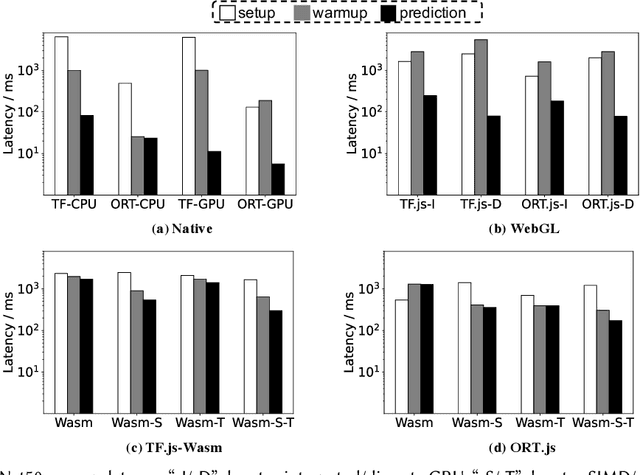
Abstract:Deep Learning (DL) is increasingly being integrated into Web applications through a method known as "in-browser inference", where the DL processes occur directly within Web browsers. However, the actual performance of this method and its effect on user experience quality (QoE) is not well-understood. This gap in knowledge necessitates new forms of QoE measurement, going beyond traditional metrics such as page load time. To address this, we conducted the first extensive performance evaluation of in-browser inference. We introduced new metrics for this purpose: responsiveness, smoothness, and inference accuracy. Our thorough study included 9 widely-used DL models and tested them across 50 popular PC Web browsers. The findings show a significant latency issue with in-browser inference: it's on average 16.9 times slower on CPU and 4.9 times slower on GPU than native inference methods. Several factors contribute to this latency, including underused hardware instruction sets, inherent delays in the runtime environment, resource competition within the browser, and inefficiencies in software libraries and GPU abstractions. Moreover, in-browser inference demands a lot of memory, sometimes up to 334.6 times more than the size of the DL models themselves. This excessive memory usage is partly due to suboptimal memory management. Additionally, we noticed that in-browser inference increases the time it takes for graphical user interface (GUI) components to load in web browsers by a significant 67.2\%, which severely impacts the overall QoE for users of web applications that depend on this technology.
A Survey of Resource-efficient LLM and Multimodal Foundation Models
Jan 16, 2024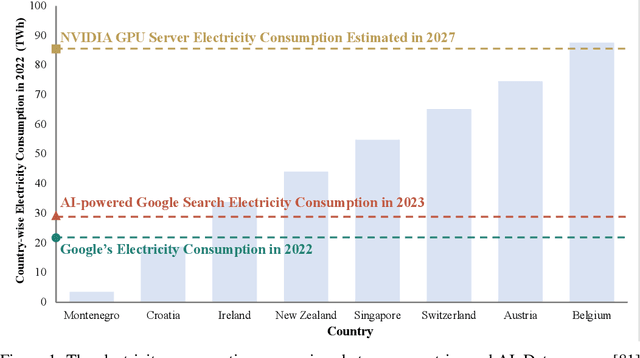
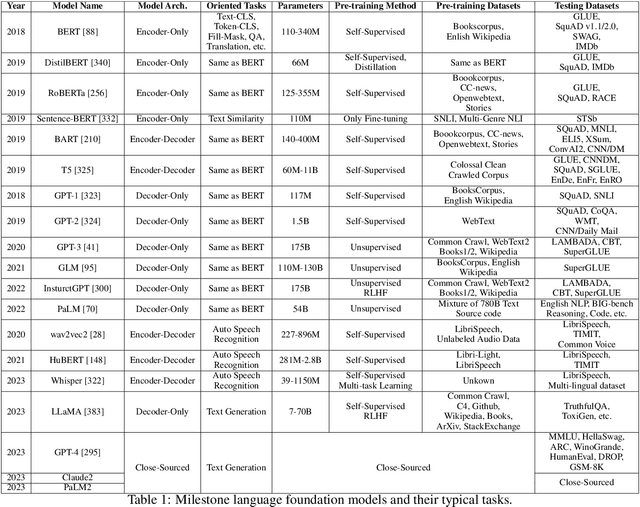
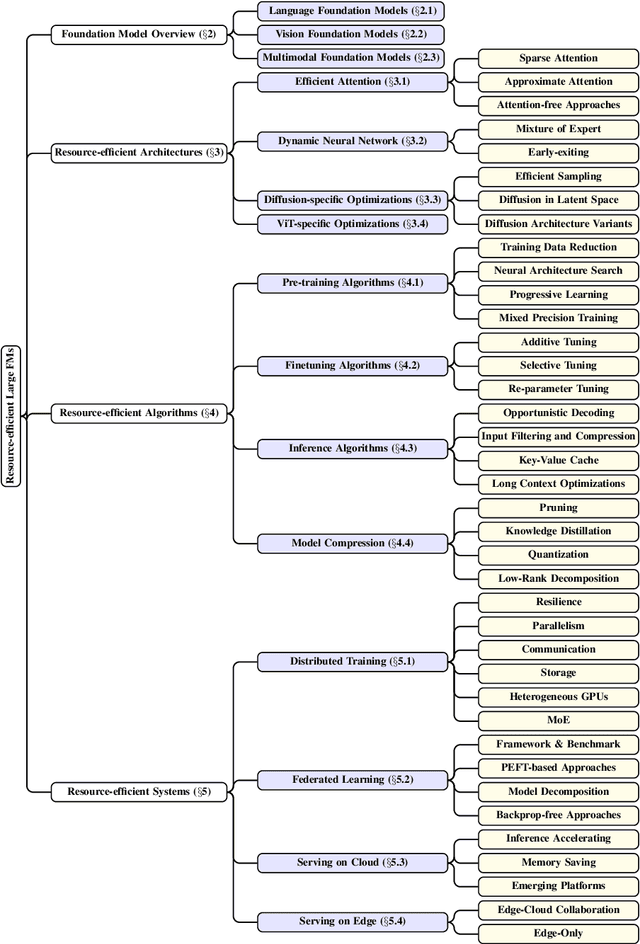
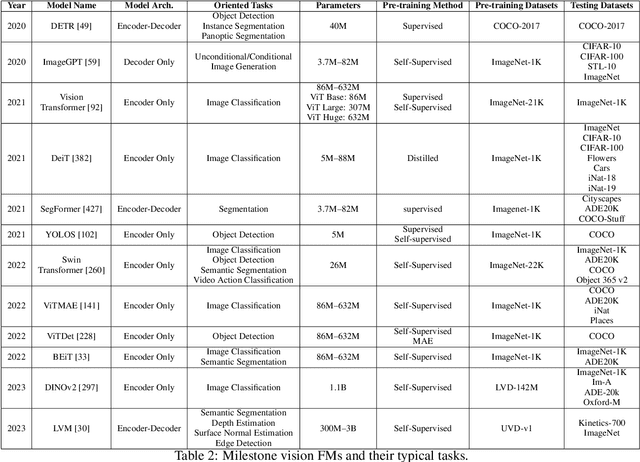
Abstract:Large foundation models, including large language models (LLMs), vision transformers (ViTs), diffusion, and LLM-based multimodal models, are revolutionizing the entire machine learning lifecycle, from training to deployment. However, the substantial advancements in versatility and performance these models offer come at a significant cost in terms of hardware resources. To support the growth of these large models in a scalable and environmentally sustainable way, there has been a considerable focus on developing resource-efficient strategies. This survey delves into the critical importance of such research, examining both algorithmic and systemic aspects. It offers a comprehensive analysis and valuable insights gleaned from existing literature, encompassing a broad array of topics from cutting-edge model architectures and training/serving algorithms to practical system designs and implementations. The goal of this survey is to provide an overarching understanding of how current approaches are tackling the resource challenges posed by large foundation models and to potentially inspire future breakthroughs in this field.
MUSIC Algorithm for IRS-Assisted AOA Estimation
Sep 06, 2023Abstract:Based on the signals received across its antennas, a multi-antenna base station (BS) can apply the classic multiple signal classification (MUSIC) algorithm for estimating the angle of arrivals (AOAs) of its incident signals. This method can be leveraged to localize the users if their line-of-sight (LOS) paths to the BS are available. In this paper, we consider a more challenging AOA estimation setup in the intelligent reflecting surface (IRS) assisted integrated sensing and communication (ISAC) system, where LOS paths do not exist between the BS and the users, while the users' signals can be transmitted to the BS merely via their LOS paths to the IRS as well as the LOS path from the IRS to the BS. Specifically, we treat the IRS as the anchor and are interested in estimating the AOAs of the incident signals from the users to the IRS. Note that we have to achieve the above goal based on the signals received by the BS, because the passive IRS cannot process its received signals. However, the signals received across different antennas of the BS only contain AOA information of its incident signals via the LOS path from the IRS to the BS. To tackle this challenge arising from the spatial-domain received signals, we propose an innovative approach to create temporal-domain multi-dimension received signals for estimating the AOAs of the paths from the users to the IRS. Specifically, via a proper design of the user message pattern and the IRS reflecting pattern, we manage to show that our designed temporal-domain multi-dimension signals can be surprisingly expressed as a function of the virtual steering vectors of the IRS towards the users. This amazing result implies that the classic MUSIC algorithm can be applied to our designed temporal-domain multi-dimension signals for accurately estimating the AOAs of the signals from the users to the IRS.
A Heterogeneous 6G Networked Sensing Architecture with Active and Passive Anchors
May 04, 2023



Abstract:In the future 6G integrated sensing and communication (ISAC) cellular systems, networked sensing is a promising technique that can leverage the cooperation among the base stations (BSs) to perform high-resolution localization. However, a dense deployment of BSs to fully reap the networked sensing gain is not a cost-efficient solution in practice. Motivated by the advance in the intelligent reflecting surface (IRS) technology for 6G communication, this paper examines the feasibility of deploying the low-cost IRSs to enhance the anchor density for networked sensing. Specifically, we propose a novel heterogeneous networked sensing architecture, which consists of both the active anchors, i.e., the BSs, and the passive anchors, i.e., the IRSs. Under this framework, the BSs emit the orthogonal frequency division multiplexing (OFDM) communication signals in the downlink for localizing the targets based on their echoes reflected via/not via the IRSs. However, there are two challenges for using passive anchors in localization. First, it is impossible to utilize the round-trip signal between a passive IRS and a passive target for estimating their distance. Second, before localizing a target, we do not know which IRS is closest to it and serves as its anchor. In this paper, we show that the distance between a target and its associated IRS can be indirectly estimated based on the length of the BS-target-BS path and the BS-target-IRS-BS path. Moreover, we propose an efficient data association method to match each target to its associated IRS. Numerical results are given to validate the feasibility and effectiveness of our proposed heterogeneous networked sensing architecture with both active and passive anchors.
Trilateration-Based Device-Free Sensing: Two Base Stations and One Passive IRS Are Sufficient
May 27, 2022

Abstract:The classic trilateration technique can localize each target based on its distances to three anchors with known coordinates. Usually, this technique requires all the anchors and targets, e.g., the satellites and the mobile phones in Global Navigation Satellite System (GNSS), to actively transmit/receive radio signals such that the delay of the one-way radio signal propagated between each anchor and each target can be measured. Excitingly, this paper will show that the trilateration technique can be generalized to the scenario where one of the three anchors and all the targets merely reflect the radio signals passively as in radar networks, even if the propagation delay between the passive IRS and the passive targets is difficult to be measured directly, and the data association issue for multi-sensor multi-target tracking arises. Specifically, we consider device-free sensing in a cellular network consisting of two base stations (BSs), one passive intelligent reflecting surface (IRS), and multiple passive targets, to realize integrated sensing and communication (ISAC). The two BSs transmit the orthogonal frequency division multiplexing (OFDM) signals in the downlink and estimate the locations of the targets based on their reflected signals via/not via the IRS. We propose an efficient trilateration-based strategy that can first estimate the distances of each target to the two BSs and the IRS and then localize the targets. Numerical results show that the considered networked sensing architecture with heterogenous anchors can outperform its counterpart with three BSs.
Exploiting Temporal Side Information in Massive IoT Connectivity
Jan 05, 2022



Abstract:This paper considers the joint device activity detection and channel estimation problem in a massive Internet of Things (IoT) connectivity system, where a large number of IoT devices exist but merely a random subset of them become active for short-packet transmission in each coherence block. In particular, we propose to leverage the temporal correlation in device activity, e.g., a device active in the previous coherence block is more likely to be still active in the current coherence block, to improve the detection and estimation performance. However, it is challenging to utilize this temporal correlation as side information (SI), which relies on the knowledge about the exact statistical relation between the estimated activity pattern for the previous coherence block (which may be imperfect with unknown error) and the true activity pattern in the current coherence block. To tackle this challenge, we establish a novel SI-aided multiple measurement vector approximate message passing (MMV-AMP) framework. Specifically, thanks to the state evolution of the MMV-AMP algorithm, the correlation between the activity pattern estimated by the MMV-AMP algorithm in the previous coherence block and the real activity pattern in the current coherence block is quantified explicitly. Based on the well-defined temporal correlation, we further manage to embed this useful SI into the denoiser design under the MMV-AMP framework. Specifically, the SI-based soft-thresholding denoisers with binary thresholds and the SI-based minimum mean-squared error (MMSE) denoisers are characterized for the cases without and with the knowledge of the channel distribution, respectively. Numerical results are given to show the significant gain in device activity detection and channel estimation performance brought by our proposed SI-aided MMV-AMP framework.
On Massive IoT Connectivity with Temporally-Correlated User Activity
Jan 27, 2021


Abstract:This paper considers joint device activity detection and channel estimation in Internet of Things (IoT) networks, where a large number of IoT devices exist but merely a random subset of them become active for short-packet transmission at each time slot. In particular, we propose to leverage the temporal correlation in user activity, i.e., a device active at the previous time slot is more likely to be still active at the current moment, to improve the detection performance. Despite the temporally-correlated user activity in consecutive time slots, it is challenging to unveil the connection between the activity pattern estimated previously, which is imperfect but the only available side information (SI), and the true activity pattern at the current moment due to the unknown estimation error. In this work, we manage to tackle this challenge under the framework of approximate message passing (AMP). Specifically, thanks to the state evolution, the correlation between the activity pattern estimated by AMP at the previous time slot and the real activity pattern at the previous and current moment is quantified explicitly. Based on the well-defined temporal correlation, we further manage to embed this useful SI into the design of the minimum mean-squared error (MMSE) denoisers and log-likelihood ratio (LLR) test based activity detectors under the AMP framework. Theoretical comparison between the SI-aided AMP algorithm and its counterpart without utilizing temporal correlation is provided. Moreover, numerical results are given to show the significant gain in activity detection accuracy brought by the SI-aided algorithm.
Thompson Sampling for Combinatorial Semi-bandits with Sleeping Arms and Long-Term Fairness Constraints
May 14, 2020
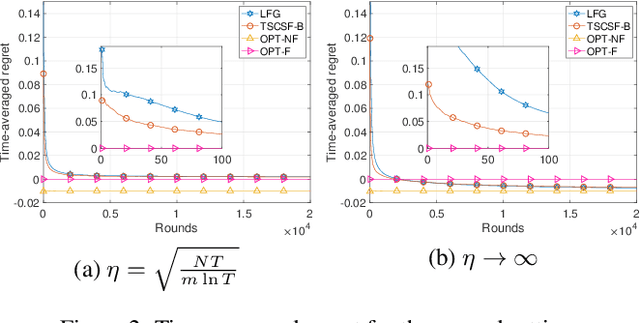
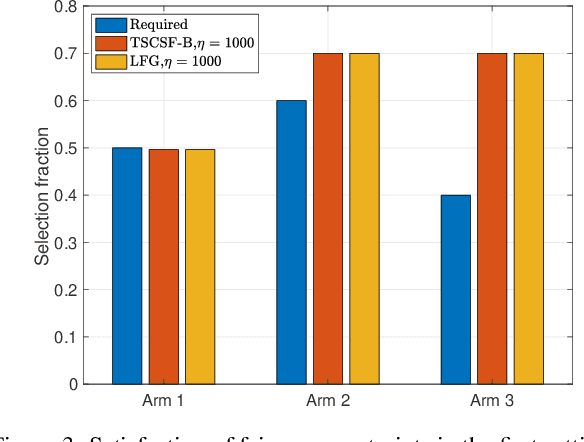
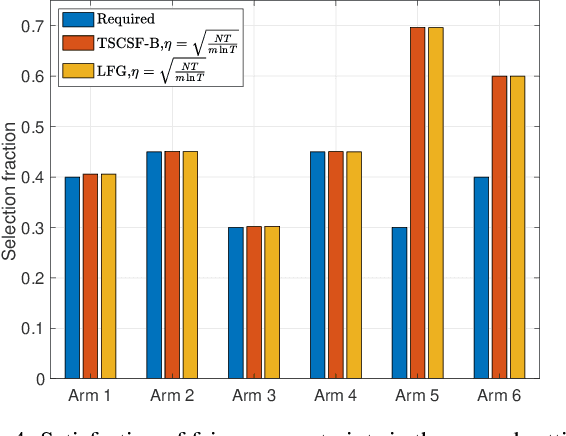
Abstract:We study the combinatorial sleeping multi-armed semi-bandit problem with long-term fairness constraints~(CSMAB-F). To address the problem, we adopt Thompson Sampling~(TS) to maximize the total rewards and use virtual queue techniques to handle the fairness constraints, and design an algorithm called \emph{TS with beta priors and Bernoulli likelihoods for CSMAB-F~(TSCSF-B)}. Further, we prove TSCSF-B can satisfy the fairness constraints, and the time-averaged regret is upper bounded by $\frac{N}{2\eta} + O\left(\frac{\sqrt{mNT\ln T}}{T}\right)$, where $N$ is the total number of arms, $m$ is the maximum number of arms that can be pulled simultaneously in each round~(the cardinality constraint) and $\eta$ is the parameter trading off fairness for rewards. By relaxing the fairness constraints (i.e., let $\eta \rightarrow \infty$), the bound boils down to the first problem-independent bound of TS algorithms for combinatorial sleeping multi-armed semi-bandit problems. Finally, we perform numerical experiments and use a high-rating movie recommendation application to show the effectiveness and efficiency of the proposed algorithm.
 Add to Chrome
Add to Chrome Add to Firefox
Add to Firefox Add to Edge
Add to Edge